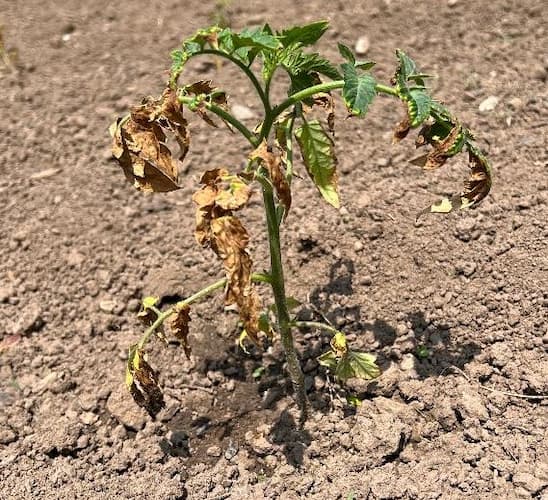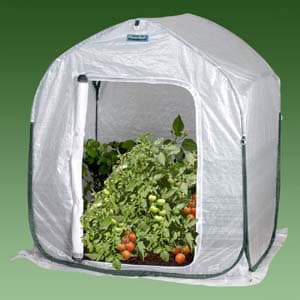Frost Protection For Plants

About Protecting Plants from Frost
The lucky people who live in frost-free areas of the country need not worry about protecting their plants from frost. Most likely, they are not even reading this article. Why should they!? However, for the rest of us, frost protection for plants is an all important topic. A late Spring or an early Fall frost or freeze damages or kills plants with impunity. So, when warnings are posted we need to react immediately.
An unexpected frost is a gardener’s worst-case scenario. The weather forecast did not predict it. As a result, your frost-sensitive plants are stunted or killed. In the Spring, you swallow the expense of purchasing new plants and seeds. And, the new plants are off to a late start which translates into a later and reduced harvest. In the Fall, your harvest comes to a grinding halt earlier than you hoped. This too results in a smaller harvest.
A frost or freeze warning is a call to action. It can send a gardener into a panic. Especially, if it’s short notice, or at a time when you are busy. Or heaven forbid, the temperatures are expected to get icy when you’re away from home. These warnings bring all of your other activities to a halt until you’ve set up frost protection for your plants.
Did You Know? Unless you live in Hawaii or Puerto Rico, there are relatively few totally frost-free areas in the United States. Even parts of Florida have occasional frosts and freezes. Frost warnings can occur as far south as the Orlando area.

How Frost Forms and Damages Plants
Frost forms on cold, usually cloudless and windless nights. These are the perfect weather conditions for dew to settle onto the leaves of plants. The lack of clouds accelerates radiational cooling. In these conditions, the water on plant leaves turns frozen. It usually occurs at 32° F. But, damaging frost can occur in temperatures as high as 40° F.
How a frost or a freeze damages plants:
First, as water freezes, it expands. This damages the cells of plant leaves and stems.
Second, as the sun rises the clear frost acts as a magnifying glass and literally fries the leaves under the frozen ice.
Stunt Damage from Cold Weather:
Importantly, very cold, near-frost conditions, can stunt the plants. This is potentially worse than a killing frost. At first, the plants do not appear damaged. However, after several days, it becomes clear the plants are stunted. The plants show little or no growth. A stunted plant will almost never regain its vigorous growth. At this point, the only solution is to replace them. Meanwhile, you’ve lost valuable time.
General Frost Protection Rules and Guidelines
Here are some general rules and guidelines to help you protect your plants from frost:
- You don’t have to buy expensive frost protection products. Almost any type of cover will do.
- As a general rule, when in doubt, cover up your plants.
- Ideally, cover the plants all the way to the ground. Residual warmth radiates up from the ground and helps to keep the temperature a little warmer inside of the cover.
- After very cold weather, be vigilant for signs of stunted plants. At the first signs, replant them.
- It is very important to uncover your plants the next morning. If you forget and go to work, you will likely come home to find the plants dead after baking all day inside the now hot cover.
- Some plants are more susceptible than others. Learn which plants are sensitive to cold and frost. For example, perennials are much more cold-hardy than annuals.
- Got just one or two plants? Something as simple as a fan blowing across the plants will keep dew from forming and freezing on the leaves of the plant.
Did You Know? During cold nights, plant and fruit growth slows to a halt. Covering plants up during cold weather keeps the plant and ground warmer. As a result, the plant and fruit grow faster as the weather warms back up.

Spring Frost Protection for Plants
Protecting plants from frost in the Spring is much easier than protecting them in the Fall. Seedlings that have not yet sprouted are protected under the soil. The first step, is to bring young plants that are not yet in the ground into a greenhouse, your garage, or your home. That leaves young plants in the ground and sprouted seedlings in need of some protection.
In the spring, young cold-sensitive garden plants are small. This makes the task of covering them up easier. Almost any type of cover will suffice. It doesn’t have to be a store-bought item. Use a five-gallon bucket or an empty flowerpot. Place it upside down over the plant. Large “Solo” cups are an excellent cover up, too. Place them over small plants. (See the picture at the top of this article.) Solo cups are susceptible to falling over in the slightest breeze. So, place a clump of soil, or a small rock on top of each one. Then in the morning, it is important to remove the covers. On frosty mornings, the sun almost always rises into a clear sky. The sun can quickly overheat plants left inside of a cover.
Garden Tip: Covers with small holes on the top will release excess heat, making them safer for use after sunrise.
Fall Plant Frost Protection
Gardeners seek ways to extend the gardening season as far into the fall as possible. After all, every additional day at the end of the season means a few more free and tasty tomatoes. But, protecting plants from an early Fall frost is often problematic. Near the end of the season, many plants are large, and vining plants are many feet long.
It is tedious and time-consuming to construct a frame around and over tall plants so you can drape a sheet, blanket, or tarp over them. But, if there’s lots of near ripe fruit on the plants, it may be well worth the effort.
For vining crops like cucumbers and pumpkins, a bedsheet, or a plastic sheet may be the difference between an end of season frost and harvesting that almost ripe melon. If a few leaves are broken in covering up the plant, it’s not important. What is important, is that you saved the plant to grow another day or perhaps even a week.
Related Articles
People who like this article on Frost Protection will also like:
Please support our site. Shop for:
- rmmatthews100@hotmail.com
- 585-721-6528
- Rochester, NY
©1999-2024 GardenersNet.Com, All Rights Reserved

